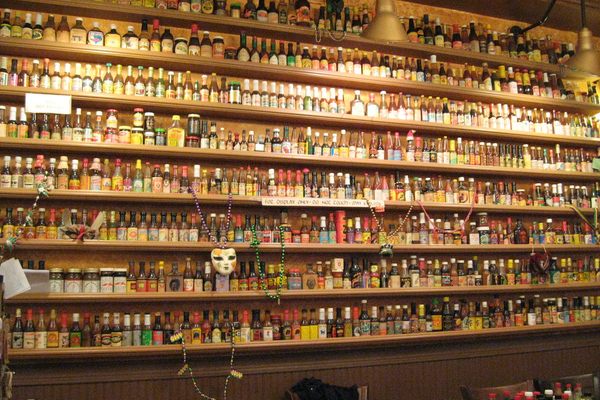The University of Chicago’s Seven-Decade-Running Jewish Food Debate
An unwinnable fight between latkes and hamantashen.

When debating the merits of latkes, the fried potato pancakes eaten at Hanukkah, and hamantashen, the triangular pastries eaten at the Jewish festival of Purim, the most obvious arguments are there on the plate.
Hamantashen will welcome almost any sweet filling into their warm embrace—poppy seeds, prunes, dates, apples, raisins. But latkes do double duty, working with either apple sauce or sour cream according to your sweet or savory tooth. One downside of the latke is that a cold one goes down like a lead balloon, and sits on your stomach almost as heavily. Hamantashen, meanwhile, are equally good (but some might say equally bad) at almost any temperature.
More sophisticated arguments require a bit more thought. Are hamantashen the feminist choice (a pastry womb cradling a sacred prune filling)? Should any psychoanalyst pick latkes (are you sure it’s Freud, and not Fryed)? These arguments, and others, are the product of 71 years of over-analysis by some of the most eminent thinkers of the University of Chicago.
Since 1946, students and staff have gathered annually to watch a formal debate over the two foods. Three debaters and a moderator—all plucked from the university’s hallowed academic staff—dispute the merits of these two Jewish foods. No one ever really wins, and certain rules apply: The three speakers must hold PhDs or equivalent qualifications, at least one must be a woman, and, to introduce a note of “gentility,” one non-Jew must speak. More recently, speakers have been permitted to argue for whichever side they choose, occasionally resulting in a debate where one argument after another favors latkes. (This doesn’t seem to happen for hamantashen.) Sometimes, a speaker will argue in favor of another Jewish food—gefilte fish, say, or the holy bagel. But the conversation always returns to these two treats: one round, one triangular.

The most common backstory of the tradition dates back to a cold Chicago day shortly after the end of the Second World War. Rabbi Maurice Pekarsky was the director of the University of Chicago Hillel, an on-campus Jewish group. Pekarsky was concerned by what his wife, Nell, remembered as a chilly atmosphere for Jewish students and staff on campus, particularly in the run-up to Christmas, with its various pageants, parties, and choral concerts.
But there was another consideration that stretched beyond the campus’s boundaries. “Immediately after the war,” writes the late cultural anthropologist Ruth Fredman Cernea in the introduction to The Great Latke-Hamantash Debate, “Jews were just beginning to venture far from the urban universities in the East, and Jewish identity was a problematic ingredient in the quest for acceptance in the scholarly world.” Faculty members sometimes found it hard to reconcile secular scholarship with Jewish tradition. This made being Jewish on campus a potentially alienating, lonely experience for students and scholars alike.
On a street corner in Chicago’s Hyde Park, Pekarsky discussed this problem with historian Louis Gottshalk and anthropologist Sol Tax. Something had to be done, writes Cernea—and so, over the course of the conversation, they agreed on a Hanukkah debate in which these two familiar foods would go head-to-head in the campus Hillel House. The jury would be furnished with latkes, applesauce, and sour cream (presumably because the debate usually coincides with Hanukkah), and Jews from all corners of university life would be welcomed to enjoy the wordplay, the parody, and the celebration of Jewish cultural life.

As time went on, it wasn’t just the university’s burgeoning Jewish population that sought a bit of levity in the Chicago gloom. The debate’s popularity grew and grew: Within two decades, the audience was too large for the Hillel House, and the event was relocated to a majestic Victorian hall on campus. Each year, as many as 900 audience members attend this friendly tussle and listen to Rhythm and Jews, an a cappella group on campus. The free food surely doesn’t hurt attendance either.
The University of Chicago is sometimes thought of as a particularly serious place. Amid the winter darkness, this evening of pre-finals hilarity allows the university to make fun of itself—a rare kind of academic “carnival.” As a result, the university’s rigorous standards of scholarship are not always applied during the debate. Despite hauling in such high-profile speakers as the linguist and scientist Steven Pinker, the philosopher Martha Nussbaum, and the Nobel prize-winning economist Milton Friedman, the arguments can be silly. Or, as the Chinese historian Judith Zeitland put it: “How rarely in academic life these days are we actually granted an occasion on which to act out our deepest and most atavistic impulses: to indulge in arguments as pompous, spurious, specious, and tasteless as we please?” This preceded an argument entitled “The Secret History of the Hamantash in China.” (The cookie, she argued, is actually a dumpling.)
Some debates have focused on the shapes of the treats, and what that might represent. Latkes are like Puerto Rico; they are like galaxies, the universe, the round oneness of heaven and earth. But hamantashen are shaped like India or the Roman Empire. And if you take one hamantash in each palm—surely the way they are supposed to be eaten, why else would we have two hands?—and lay them on top of each other, they form the Star of David. Other thinkers have found answers in literature—in Shakespeare or the lesser-known Jane Austen work Love and Latkes. (A blurb for this so-called “lost” text: “The sprightly young heroine comes to discover that love lies heavy at her heart, and the rather less witty hero finds out that latkes don’t sit so light in the stomach either.”)

The arguments sometimes takes a more serious tone, as in the 1976 debate, “Which Has Done More to Save the Jewish People: The Latke or the Hamantash?” Costume varies too—a convincing presentation may require full academic dress, or a samurai costume. At least once, an appeal has been made to national identity: Potatoes are an American foodstuff exported to Europe and perfected in the Old World, as the latke. How could any self-respecting American Jew vote for any other food?
A debate originally conceived to bring the campus Jewish community together has instead united the entire university—Jews and non-Jews alike. In doing so, writes Cernea, those once on the outside are now at the center: “The outsiders’ ultimate in-group event is now the emblem of Jewish integration at the university.” When moderating the 2015 debate, Hal Weitzman put it a little differently. “If you take hamantash, you remove the butter and the sugar, the jam and the baking powder, the vanilla extract and the orange zest, and then you add potatoes and onions and deep fry it, what you get is [a] latke. And that just goes to show how similar we all are at our core.”
Gastro Obscura covers the world’s most wondrous food and drink.
Sign up for our email, delivered twice a week.
























Follow us on Twitter to get the latest on the world's hidden wonders.
Like us on Facebook to get the latest on the world's hidden wonders.
Follow us on Twitter Like us on Facebook